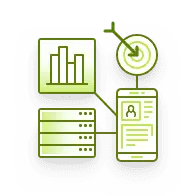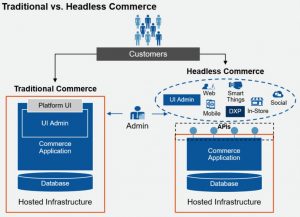What is headless commerce and what are the benefits?
November 28, 2019 By Stacey Woods

What is headless commerce?
Headless commerce (also known as API-driven or API-first commerce) is all the rage these days, but there is a lot of confusion about what this term really means.
It is defined as an eCommerce system where the back-end is decoupled from the front-end – the presentation/experience layer or the “head” of the system – through which users interact. That’s why it is called “headless”… The front-end can get access to back-end data through well defined Application Programming Interfaces (APIs).
This is different to the more common website architectures used today, where the presentation layer and back-end are closely connected.
The following diagram from Gartner depicts the structural difference between traditional and headless commerce platforms.
Related reading: 5 Myths about wholesale eCommerce that are nowhere near the truth.
How did headless commerce come about and why?
There are two major factors that contributed to the emergence of headless commerce and its increasing popularity.
The first is that when eCommerce first came about, most websites were accessed from desktop computers. For this reason, the majority of solutions were full-stack and included a website front-end tightly connected to a back-end.
However, with the rapid advancement of technology, the world of B2C and B2B eCommerce is changing and the path that customers use to consume content and make purchases has expanded to include a multitude of other channels and touch points.
As a result, it has become increasingly difficult for businesses to keep up with these new and changing channels, as every change to the user experience means major changes to the back-end.
A headless eCommerce platform solves these challenges by separating the front-end from the back-end. This enables front-end developers to focus on the user experience and introduce new products, content, and processes on any screen or device, without having to also update the back-end. Any data required from the back-end is provided through API calls.
Secondly, some companies want to have the ability to expand into eCommerce by simply adding an eCommerce engine that easily integrates with the existing front-end system. This cannot be done with traditional platforms due to the tight connection between front-end and backend.
Benefits and challenges of headless commerce
Headless commerce offers the following benefits:
- Flexibility – When using a traditional eCommerce system, you receive an out-of-the-box presentation layer, which limits your ability to change things. With a headless eCommerce solution, your front-end developers can experiment more freely with user interfaces and have fewer limitations associated with the back-end. This gives you the flexibility to tailor customer experiences for different platforms and can also simplify the launch of new capabilities.
- Omni channel capabilities – supports omnichannel strategies as it enables businesses to push products and content and customize user experiences for different channels and platforms that emerge, without the need for major back-end customizations.
- Easy integrations – facilitates fast and seamless integrations with third-party systems.
What are the challenges?
It’s important to note that there are also challenges involved in going “headless” that need to be considered before adopting this approach:
- As opposed to traditional models where the experience layer is ready-made, headless commerce platforms do not provide you with a front-end. This means you’ll need to create user experiences from scratch, which requires a high level of expertise and can be costly.
- It may take some time to develop and fine-tune separate, highly customized user experiences. This learning curve needs to be taken into account when considering whether to adopt a headless commerce approach.
- Your back-end and APIs need to be extremely robust and flexible to support any business scenario you may need to implement, now and in the future. That’s especially important in the B2B domain, where use-cases are often very complex. If you don’t have that back-end and API robustness, you may find that you are limited with what you can be done, and the attractiveness of “headless” will diminish considerably.
So should you go headless?
The way we buy things is changing at a dizzying pace, and before we know it, consumers will be able to shop directly from pretty much any touch point. As a result, different types of eCommerce solutions are emerging with the goal of making these transitions as seamless as possible for both businesses and consumers.
In this blog post, we presented one of these solutions – headless eCommerce. While headless solutions offer quite a few benefits in terms of flexibility, their implementation also requires a high-level of front-end development expertise, a robust and flexible back-end with APIs that can support complex business scenarios, and a relatively large investment in terms of time and money.
For this reason, we recommend that you first do an in-depth analysis of your requirements and then decide which approach is best for your business and your customers.
Had enough reading about B2B eCommerce? Talk to one of our experts about your online and face-to-face B2B sales needs.
























